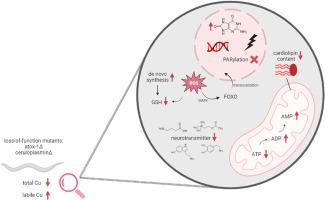Dysfunctional copper homeostasis in Caenorhabditis elegans affects genomic and neuronal stability
引用次数: 0
Abstract
While copper (Cu) is an essential trace element for biological systems due to its redox properties, excess levels may lead to adverse effects partly due to overproduction of reactive species. Thus, a tightly regulated Cu homeostasis is crucial for health. Cu dyshomeostasis and elevated labile Cu levels are associated with oxidative stress and neurodegenerative disorders, but the underlying mechanisms have yet to be fully characterized. Here, we used Caenorhabditis elegans loss-of-function mutants of the Cu chaperone ortholog atox-1 and the Cu binding protein ortholog ceruloplasmin to model Cu dyshomeostasis, as they display a shifted ratio of total Cu towards labile Cu. We applied highly selective and sensitive techniques to quantify metabolites associated to oxidative stress with focus on mitochondrial integrity, oxidative DNA damage and neurodegeneration all in the context of a disrupted Cu homeostasis. Our novel data reveal elevated oxidative stress, compromised mitochondria displaying reduced ATP levels and cardiolipin content. Cu dyshomeostasis further induced oxidative DNA damage and impaired DNA damage response as well as neurodegeneration characterized by behavior and neurotransmitter analysis. Our study underscores the essentiality of a tightly regulated Cu homeostasis as well as mitochondrial integrity for both genomic and neuronal stability.

秀丽隐杆线虫体内铜平衡失调会影响基因组和神经元的稳定性
铜(Cu)具有氧化还原特性,是生物系统不可或缺的微量元素,但过量的铜可能会导致不良影响,部分原因是活性物质的过度产生。因此,严格调节铜的平衡对健康至关重要。铜失衡和易变铜含量升高与氧化应激和神经退行性疾病有关,但其潜在机制尚未完全定性。在这里,我们利用秀丽隐杆线虫Cu伴侣蛋白直向同源物atox-1和Cu结合蛋白直向同源物ceruloplasmin的功能缺失突变体来模拟Cu失衡,因为这些突变体显示出总Cu与游离Cu的比例偏移。我们采用了高选择性和高灵敏度的技术来量化与氧化应激相关的代谢物,重点关注线粒体完整性、氧化 DNA 损伤和神经退行性变,所有这些都是在铜平衡失调的背景下发生的。我们的新数据显示,氧化应激升高,线粒体受损,显示出 ATP 水平和心磷脂含量降低。铜平衡失调进一步诱导了氧化 DNA 损伤和 DNA 损伤反应受损,以及以行为和神经递质分析为特征的神经退行性变。我们的研究强调了严格调节的铜平衡以及线粒体完整性对基因组和神经元稳定性的重要性。
本文章由计算机程序翻译,如有差异,请以英文原文为准。
求助全文
约1分钟内获得全文
求助全文

 求助内容:
求助内容: 应助结果提醒方式:
应助结果提醒方式:


